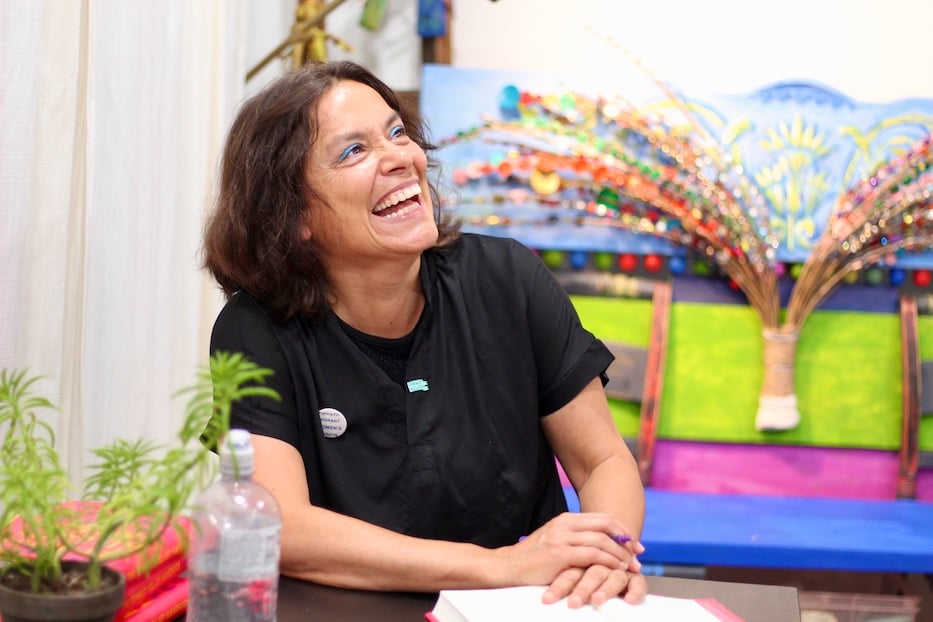
Author Sara Ahmed. Lucy Gellman Photos.
The Feminist Killjoy Handbook begins with a story. In a past universe, a young Sara Ahmed is sitting with her family at the dinner table, listening as conversation unfolds around her. At some point, her father steps in; his voice rises, a loaded slingshot aimed at his daughter. Ahmed tries to let it roll off, but she can feel the anger rising in her body. When she pushes back, her mother chides her, insisting that she has ruined another dinner.
Is Ahmed part of the problem? Or is she part of the solution?
Last Wednesday, Ahmed graced Possible Futures with a reading, discussion, and book signing for The Feminist Killjoy Handbook: The Radical Potential of Getting In The Way, released from Seal Press earlier this month. To a standing-room-only audience, the author, writer and feminist scholar spoke on the book for over an hour, stressing the importance of interrupting, speaking out, and getting into good trouble to make both the present and the future more bearable.
Luciana McClure, who co-founded Nasty Women Connecticut in 2016, and poet, spoken word artist and educator Attallah Sheppard joined her for the remarks. Throughout the evening, all three returned to the way that pushing back can be a source of power and social change, and can also open doors to those who may still be afraid to speak up.
In other words, getting in the way—and staying in the way—is equally powerful and necessary. People just have to get more comfortable with it.
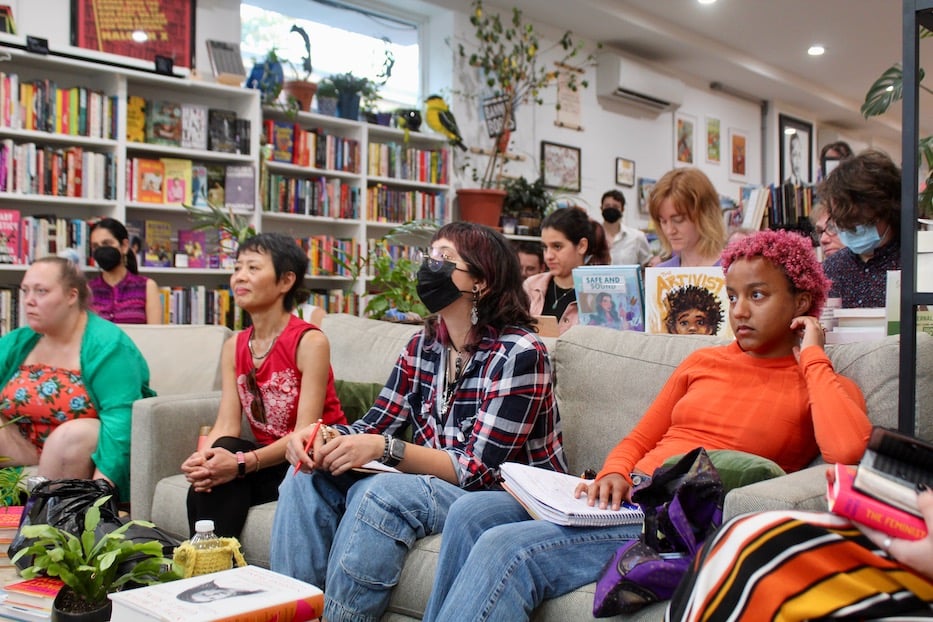
“Being a feminist killjoy—the one who gets in the way of happiness, or just gets in the way, the one who becomes the problem—it can be an isolating and lonely experience,” Ahmed said at the top of the discussion. “But it can also be how you find your companions, how you connect with others.”
In the hour that followed, she looked to both the origins of the feminist killjoy, who in the book exists well before she ever speaks back at the dinner table (or in the workplace, or in the streets, or within a large institution) and the sheer potential of embracing her fully. For Ahmed, her values are not an imposition: they are a matter of survival and a sort of kindness to society.
In this universe, which is also our universe, the feminist killjoy exists because of the baggage attached to feminism, not in spite of it. As she comes into her own, she becomes less afraid—and more convinced—of the need to intervene, even at the sake of her own or others’ happiness or comfort. As that intervention takes place, it also becomes a reclamation. Or as Ahmed herself writes in the book:
The feminist killjoy begins her political life as a stereotype of feminists, a negative judgment, a way of dismissing feminism as causing and caused by misery. In reclaiming the feminist killjoy for ourselves, we turn the judgment into a project, because if feminism causes misery, that is what we might need to cause.
Speaking Wednesday, she recalled a testimonial that she collected in the course of her research on complaint, in which a disabled woman spoke on the loneliness and exhaustion of pointing out to her colleagues that the rooms people booked were consistently inaccessible. It was emotionally draining, she’d told Ahmed: she would object to a space’s lack of access, hope for a change, and then arrive to find another space that she couldn't get into.
She knew that the burden shouldn’t be on her—but also knew that no one else would take up the cause.
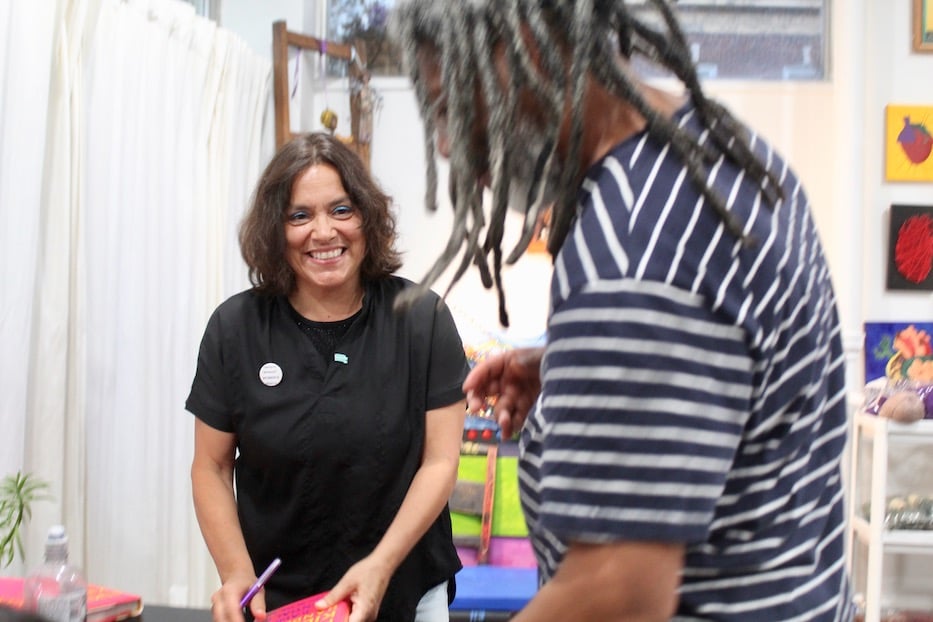
Ahmed with artist Howard El-Yasin.
“We have to keep saying it, because they keep doing it,” Ahmed said. “Because she has to point it out to get into the room, others don’t. And then it becomes her issue. She talked about how exhausting and depleting that was, but she also really listened to her sense of how much she knew about the institution, because it wasn’t enabling her to enter it. She understood how those walls kept coming up.”
“It becomes a shift—like, who is the labor on?” chimed in McClure. “And it becomes the labor that you have to keep carrying, you have to keep carrying it. [When] we think about how we support one another, what does supporting look like? Where is the solidarity?”
For Ahmed—who literally wrote the book—that looks like building community with the people who choose to interrupt, to speak out, to try to shift the paradigm. A devotee of feminist writers and thinkers from bell hooks to Audre Lorde to Toni Morrison to Ama Ata Aidoo, Ahmed noted the necessity of naming the -isms and -obias that create disruption, often as a first step to liberate oneself and do the work of getting in the way.
She added that it’s those “killjoy ancestors,” among many others, who allow her to keep going. For instance, she often thinks of her aunt, the Pakistani poet and activist Gulzar Bano, who passed away in 2015. When Ahmed was growing up, it was Bano who taught her “that I had a mind of my own,” a value that she lived through her advocacy for women and for literacy in Pakistan, she said.
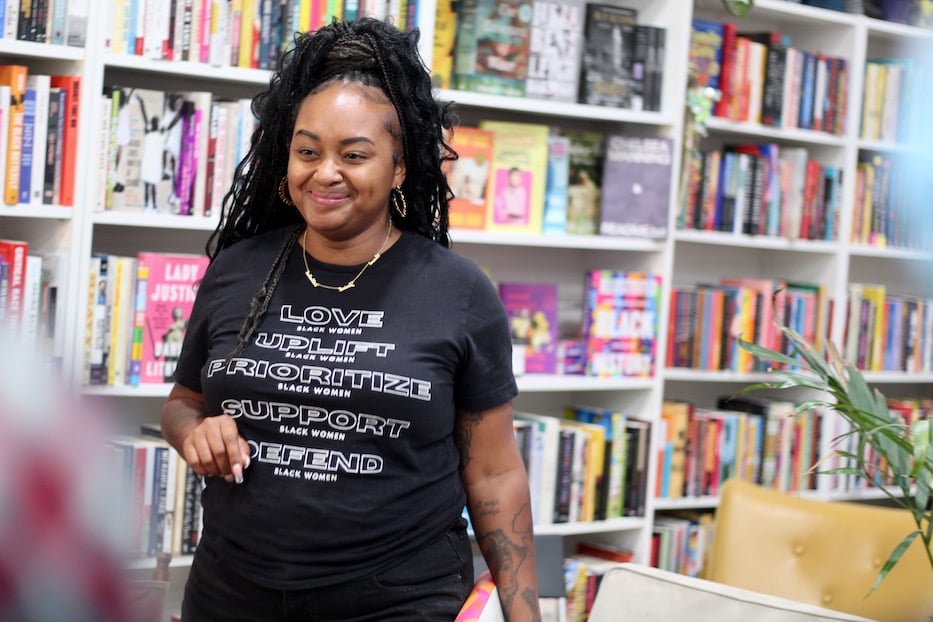
Attallah Sheppard.
“She really taught me that feminism wasn’t a Western idea,” she said as Sheppard, who had asked who Ahmed brings with her in her work, nodded thoughtfully along. “It was about thinking for ourselves about what our lives are, and our responsibilities are, and our care for others should be. So she was a real inspiration.”
That doesn't mean it’s easy to be a killjoy, she added—particularly when one is working out their objections in the context of family. And yet, joy is part of the titular word; the experience of triumph and generation can and must exist beside the isolation and discomfort of interruption.
“Where do you think creativity lives in the world of being a killjoy?” Sheppard asked. “Like, why is that important? Because, we’re pretty much creating anew, right? Society is unjust. You can’t help but be a feminist when the world is continuing to demean, destroy, and depict something that is not of you.”
Ahmed went to her chapter “The Feminist Killjoy as Poet,” pulling examples that ranged from Lorde’s poetry to Morrison’s The Bluest Eye to Aidoo’s Our Sister Killjoy, which put the terminology on the literary map when it was published in 1977. In all of those, she said, there’s a focus on language, clarity and world-building that can double as a template for how to live one’s life.
Even now, she said, she frequently returns to a scene in The Bluest Eye during which the narrator, Claudia, receives a white baby doll for which she feels no affection. “She says that she can look at it to see what the world said was loveable,” Ahmed remembered, quoting Morrison as a chorus of Mmmmms erupted across the room.
Claudia ultimately destroys the doll. For Ahmed, the outcome is a completely rational one.
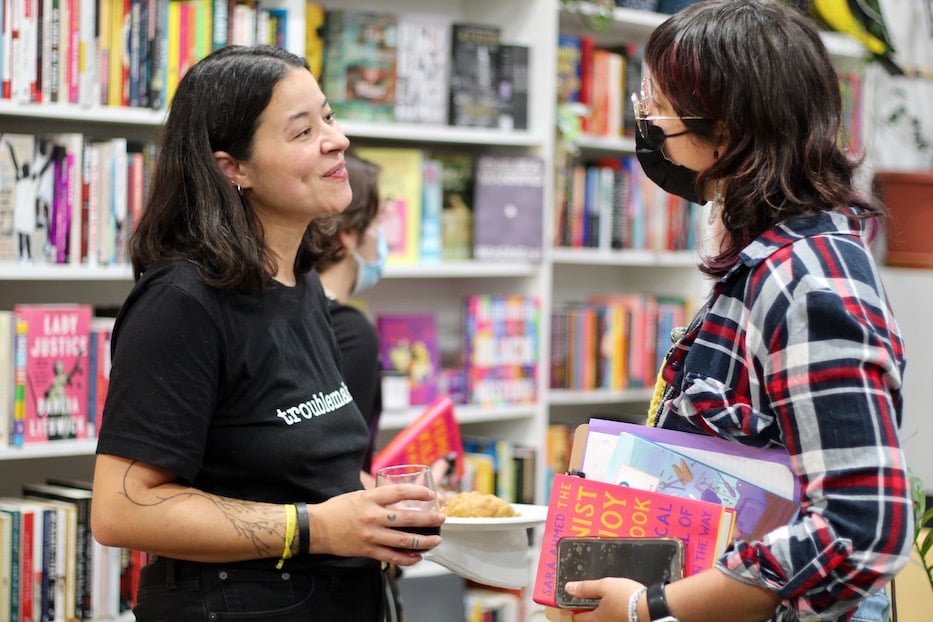
McClure, who attended the panel with a shirt that read, fittingly, "troublemaker."
“In that act which might look like vandalism, and maybe it is … there’s also a kind of creativity,” she said. “The less you see yourself in a reflection, the more you see in a reflection—but the more you think about what would it mean to create something in which more of us could see ourselves reflected. It wouldn’t be Barbie, by the way. It would be something else.”
It opened a space for questions that attendees filled, eagerly, for the better part of half an hour. Noting her own killjoy ancestors, one attendee looked at Ahmed’s interest in the word “conviviality,” and the way women have been and still are socialized to seem easygoing or conciliatory, even in situations where they are being held back or oppressed.
“I’m interested in how we move past that, and if as a community, when we are killjoys in front of one another, do we create that space where it is safer to be disruptive and to be assertive?” she asked. “Do you see that changing? Do you see the killjoy as an agent of that change?”
Ahmed recalled a colleague, who for years struggled to recognize the fact that she was being harassed in the workplace. After she finally spoke out, she confided in Ahmed that she had been afraid that she might “take herself down”—that her admission of the violence directed toward her could stymie her career and her happiness. It’s a process, Ahmed said.
“It made me realize, in a way, that a killjoy can often come up in a story of consciousness, of what it takes to become conscious of things that happen, because actually taking up less space, or not recognizing violences that happen, these are things that we do to manage and survive certain realities,” Ahmed said. “And sometimes, just recognizing what ‘s happening to you means letting something in that changes your understanding of yourself and the world.”
“I do think it requires a lot of support and a lot of safety,” she added. “I would hope part of the project of the killjoy is to do the work of creating those spaces.”
The Feminist Killjoy Handbook: The Radical Potential of Getting in the Way is available at Possible Futures.